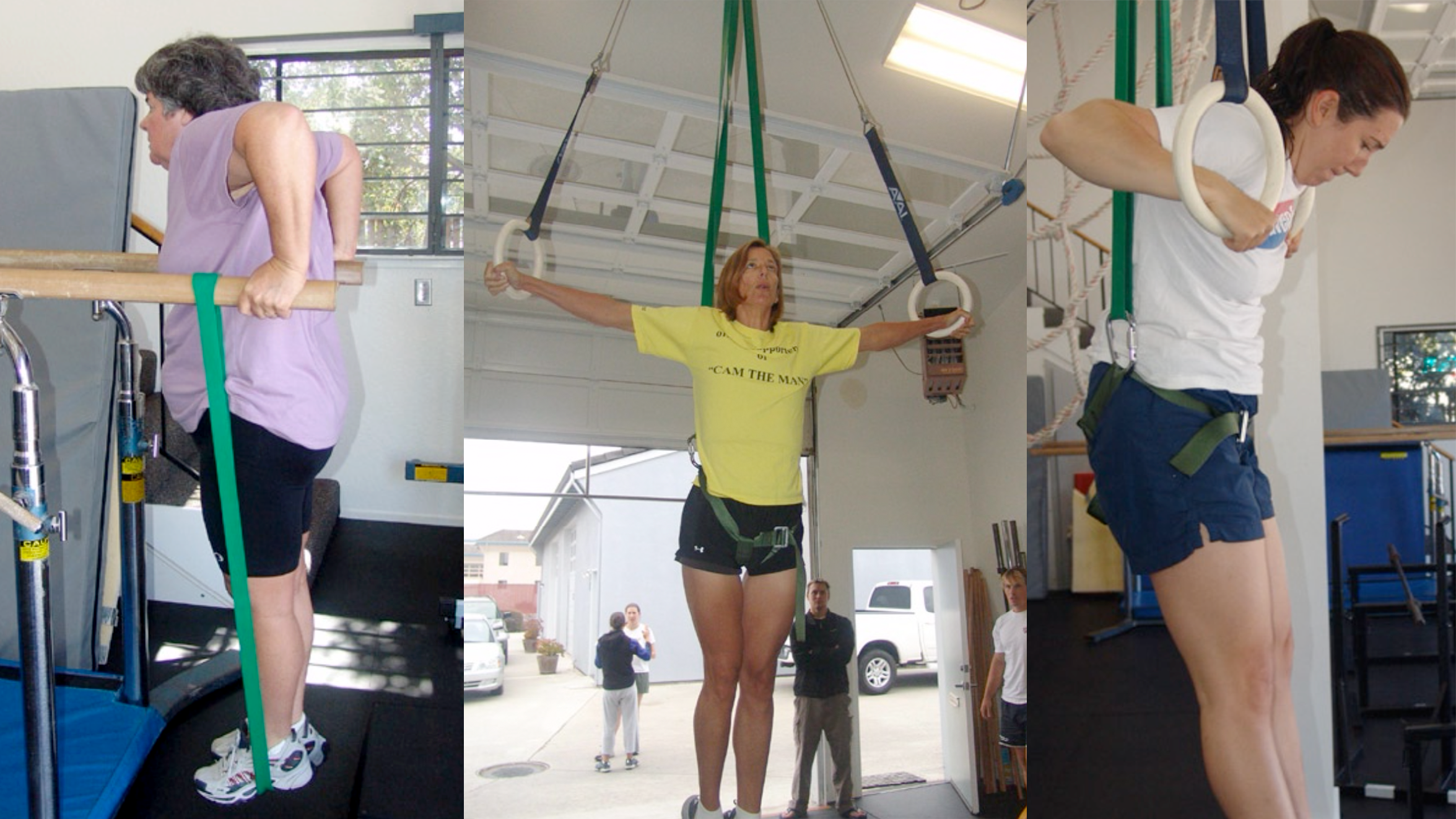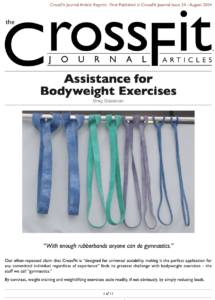By Greg Glassman
This article, by BSI’s co-founder, was originally published in The CrossFit Journal. While Greg Glassman no longer owns CrossFit Inc., his writings and ideas revolutionized the world of fitness, and are reproduced here.
Coach Glassman named his training methodology ‘CrossFit,’ which became a trademarked term owned by CrossFit Inc. In order to preserve his writings in their original form, references to ‘CrossFit’ remain in this article.
Download a pdf of the original article HERE.
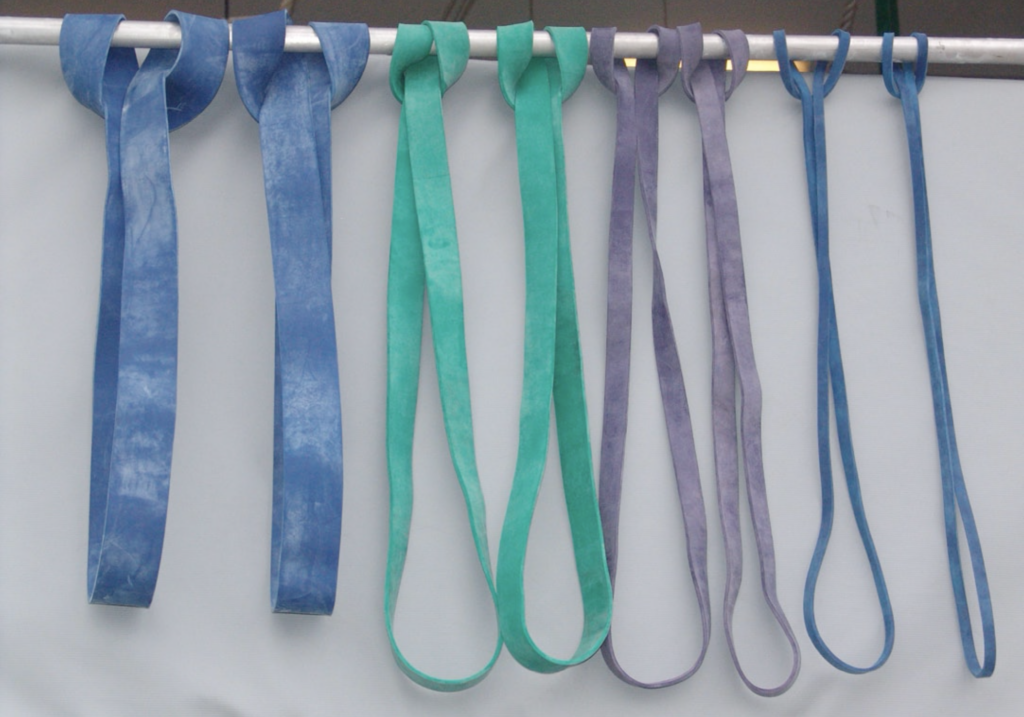
“With enough rubberbands anyone can do gymnastics.”
Our often-repeated claim that CrossFit is “designed for universal scalability making it the perfect application for any committed individual regardless of experience” finds its greatest challenge with bodyweight exercises – the stuff we call “gymnastics.”
By contrast, weight training and weightlifting exercises scale readily, if not obviously, by simply reducing loads.
With training bars and training plates we’ve been able to introduce the major lifts like squats, deadlifts, presses and jerks, cleans, and the snatch to all comers, including seniors, regardless of ability. This approach is not novel; many of the most successful and sophisticated weightlifting programs start everyone out with PVC pipe or wooden dowel systems of negligible weight and only increase loads in tiny increments when execution is good.
But bodyweight exercises create a special dilemma. Most women, seniors, and larger men are typically challenged to complete a single rep of even the most rudimentary bodyweight movements. This is most true of basic upper body exercises like the pull-up, push-up, or dip.
For years assisted pull-up and dip machines like the Stairmaster Gravitron have been our staple for introducing, training, and developing bodyweight exercises.
While we’ve met with considerable success with this approach it does have several nagging shortcomings including the substantial cost of the machines themselves, their discontinued production in the case of the Gravitron, less than optimal or natural lines of action, limited accessibility with larger numbered groups, and the inherent limitation of developing only two exercises – the pull-up and dip.
This month we explore additional assistance strategies that broaden both the pool of athletes able to participate in basic bodyweight exercises and the number of bodyweight exercises.
We’ll show how not only the pull-up and dip, but also the muscle-up, rope climb, iron cross, and handstand push-up can be worked by anyone.
Additionally, we’ll present strategies by which the front lever, planche, maltese cross, inverted cross, elevator, and ring handstand pushup can be practiced by athletes more capable yet still far from strong enough for these classics.
None of the strategies we’ve explored are our design – most can be found in Cuk and Karacsony’s book Rings – Methods, Ideas, Curiosities, and History. What is uniquely CrossFit is both using these techniques with special populations and advocating their use for nongymnastics athletic strength and conditioning.
The gymnastics realm is every bit as potent as weightlifting and weight training and nearly untapped in fitness programs, commercial gyms, military and law enforcement training, and athletic strength and conditioning worldwide.
Weight training is a critical component of fitness training but, ultimately, represents a vehicle for tapping only half of your physical potential – the rest depends on gymnastics. This is true of strength in general and upper body and core strength in particular, but in the arena of neurological development the gymnastics stimulus is singularly unique.
No discipline approaches gymnastics’ capacity for developing strength to weight ratio, upper body strength, core strength, flexibility, coordination, accuracy, agility, and balance. (Pilates fans, yogis, Swiss ballers, wobble and Indo boarders take note: you are playing, not training!)
The barrier to participation in gymnastics is twofold. The first difficulty is scaling load. Imagine if the only load available in gyms were bodyweight loads. What would that do to the popularity of weight training? It would close nearly every gym in the world. There would be as many people lifting weights as there are doing gymnastics – damned few.
The second barrier to gymnastics participation is less apparent to most athletes and coaches but every bit the impediment that scalability is. Gymnastics movements at every level require extraordinary body control. Gymnastics is to weight training as the tambourine is to the violin. Weak mindedness manifested as a low tolerance for frustration culls the herd.
Benefit from and need for the gymnastics stimulus is not blunted by age, weight, or gender. In fact, those populations least likely to find themselves above the rings or upside down benefit greatest from the exposure. Toughen up, get some rubber bands, and get to work.
Jimmy Johnson/Handstand push-ups:
Santa Cruz Sheriff’s Deputy Jimmy Johnson is a big, strong man but not ready for unassisted handstand push-ups. We attached him to a Yates ankle harness to which we added a couple of FlexBands and hauled him up to the handstand with a 4:1 block and tackle system. By controlling the tension on the bands we could precisely determine the amount of assistance Jimmy was getting and he was able to do his first handstand push-ups. On failure, we could pull a little more rope, which stretched the bands a little more, and he was good for a few more reps.
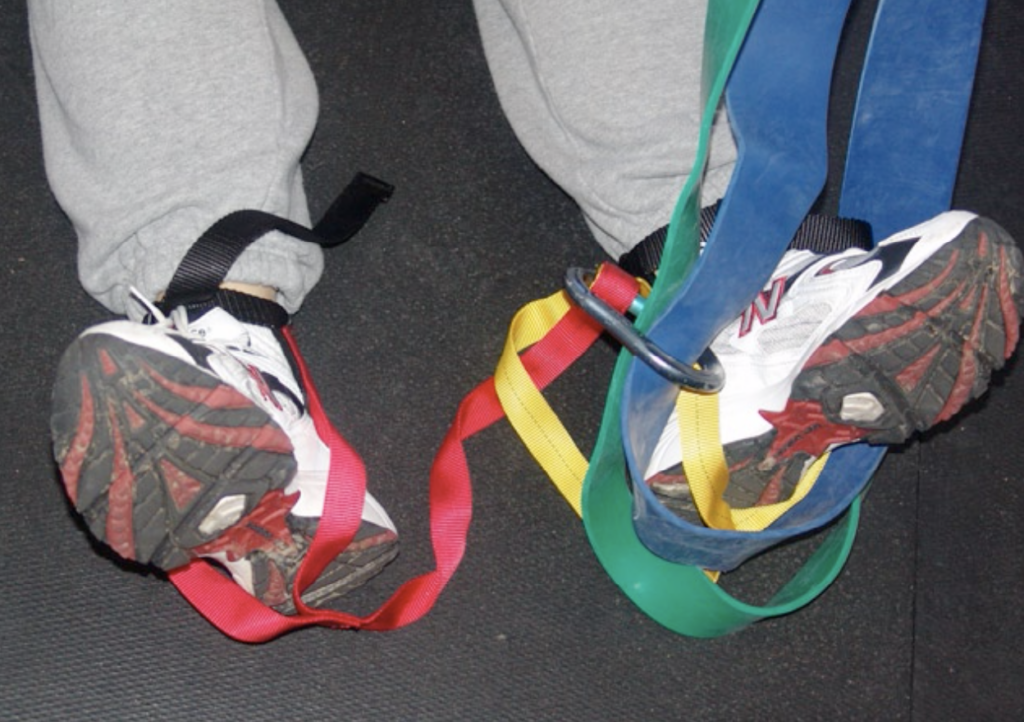
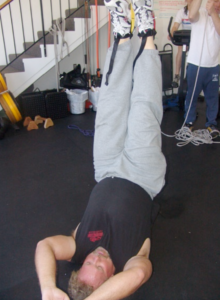
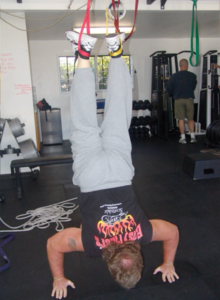
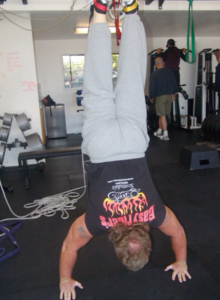
“ChemGirl”/Handstand Push-up:
By controlling the amount of pre-stretch on the FlexBands “ChemGirl” can be made as light as needed for practicing handstand push-ups.
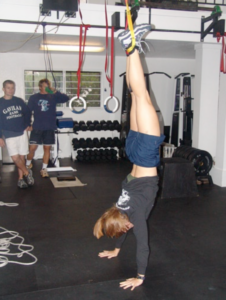
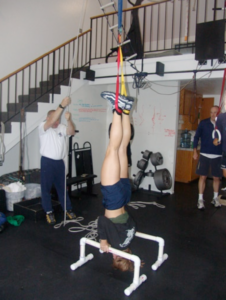
Ernie Ellender/Front Lever & Mary Poteete/Iron Cross
Both can practice their iron cross and front lever with FlexBands attached to a climbing harness and pulled tight with block and tackle.
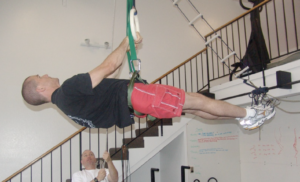
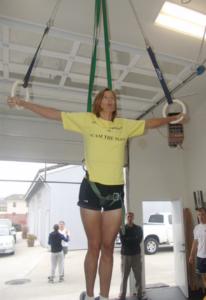
Jonna Mendes/Muscle-up:
Two time U.S. Olympian Jonna Mendes needs a little assistance for the muscle-up. We put her in a climbing harness to which we attached two FlexBands and hauled the bands upward with block and tackle precisely controlling the amount of assistance needed to get her on top of the rings.
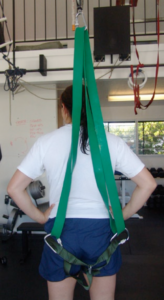
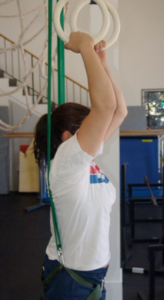
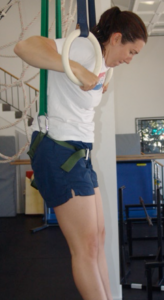
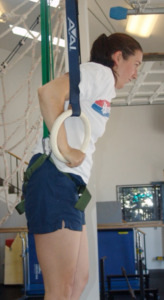
Garth Taylor/Muscle-up:
With FlexBands and block and tackle Brazilian Jiu-jitsu champion Garth “Mountain Man” Taylor can do a muscle-up.
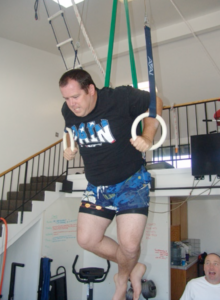
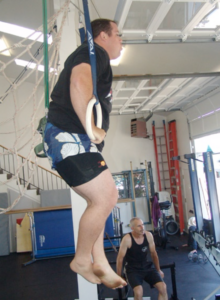
Sally Stade/Iron Cross:
Sally Stade is holding an iron cross on rings tied to ropes that run up to the ceiling, through pulleys and down to loading pins and plates. Her iron cross can be measured as a percentage of her body weight telling her how close she is to the real thing.
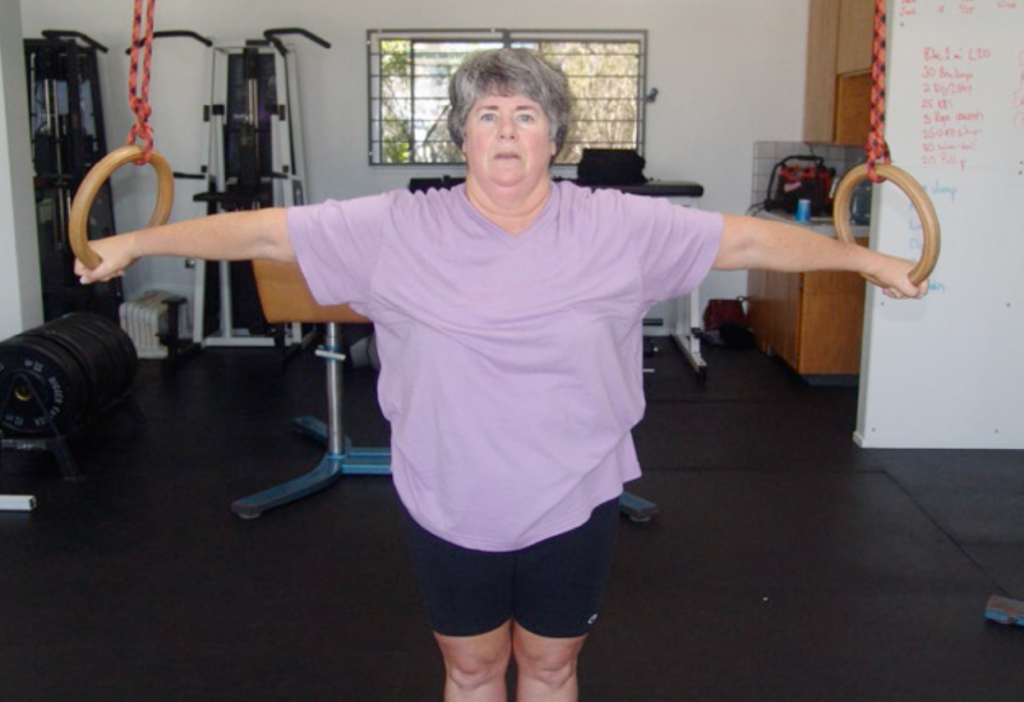
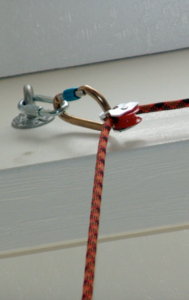
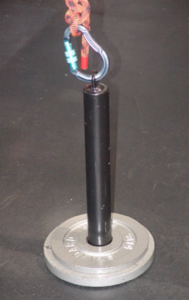
Sally Stade/Iron Muscle-Up:
Again with rings tethered to a rope that runs up to a pulley and back down to two loading pins and plates we can measure how close Sally actually is to the muscle- up.
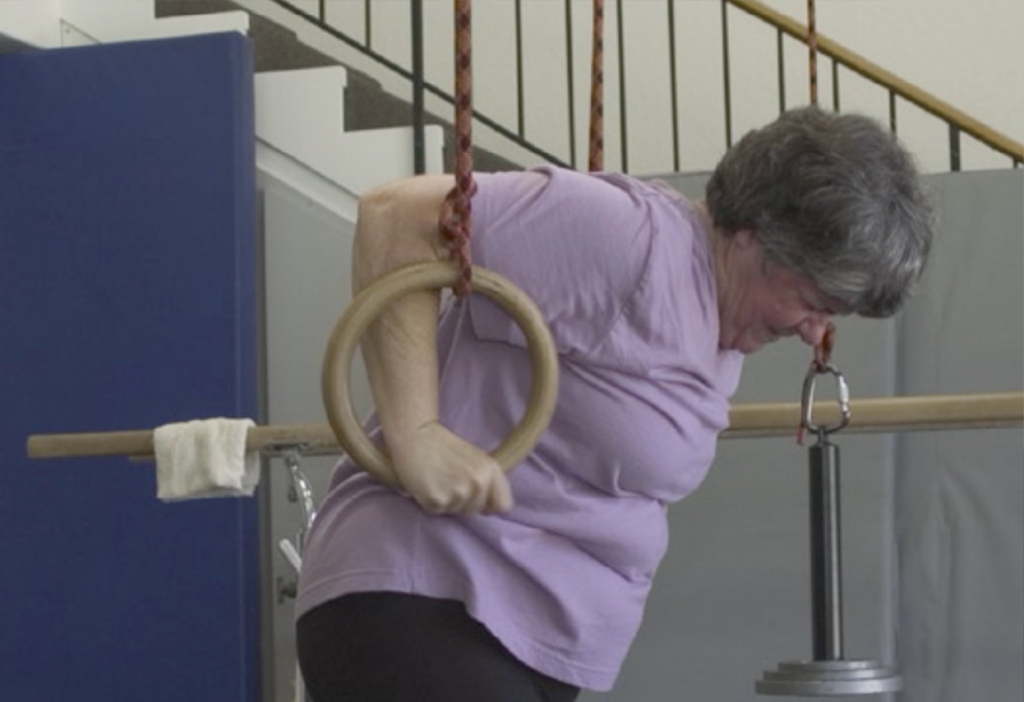
Sally Stade/Muscle-up:
This time with our rings attached to the ceiling with FlexBands, Sally Stade can practice the muscle-up without her feet ever leaving the ground. Setting the false grip becomes easy, the transition manageable and the dip adequately challenging.
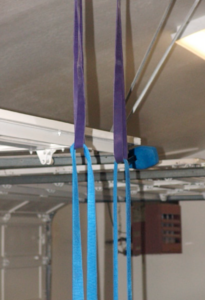
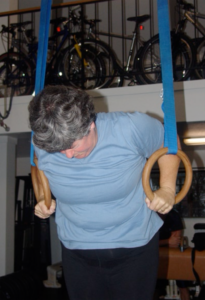
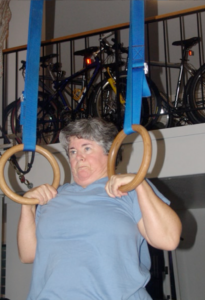
Jack Hespel/Inverted Cross:
It’s been 40 years since Jack Hespel’s gymnastics days, but with rings attached to a rope that runs up through a pulley and back down to the ankle harness Jack is back in action with an inverted cross. Again, this system cuts Jack’s weight in half.
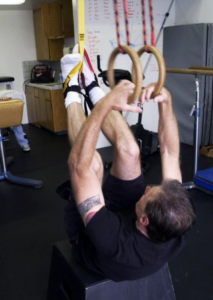
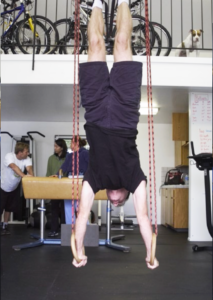
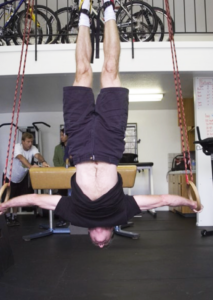
Lani Lau/Ring Handstand Push-ups:
Lani Lau is attached to the Yates ankle harness, which in turn is attached to a rope that runs up to a Petzl pulley and back down to the rings. This halves the bodyweight and allows Lani to do still-ring handstand push-ups, preserving a lot of the live feel of the real movement.
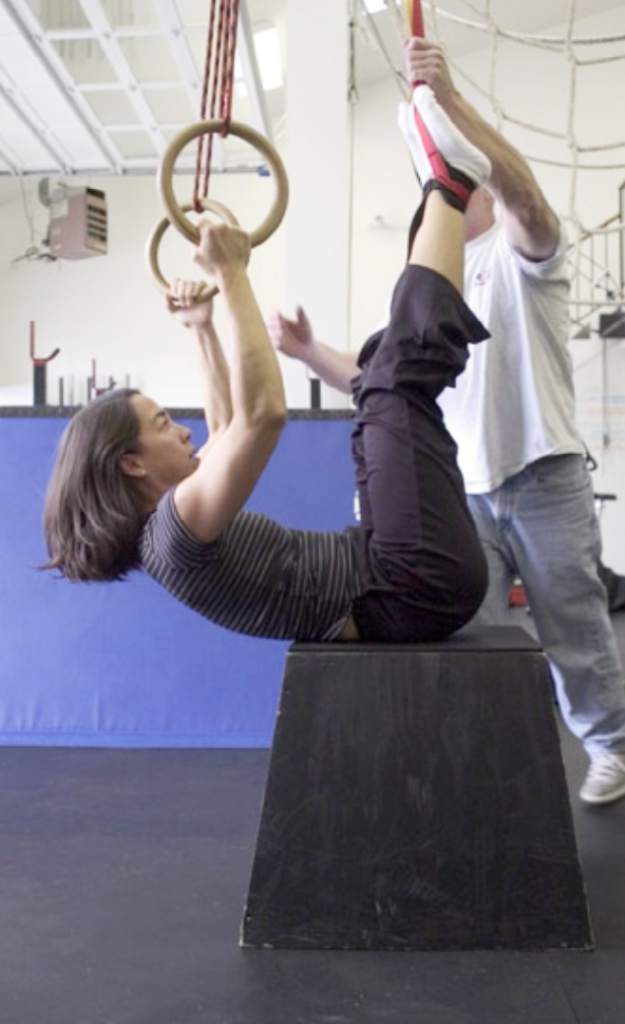
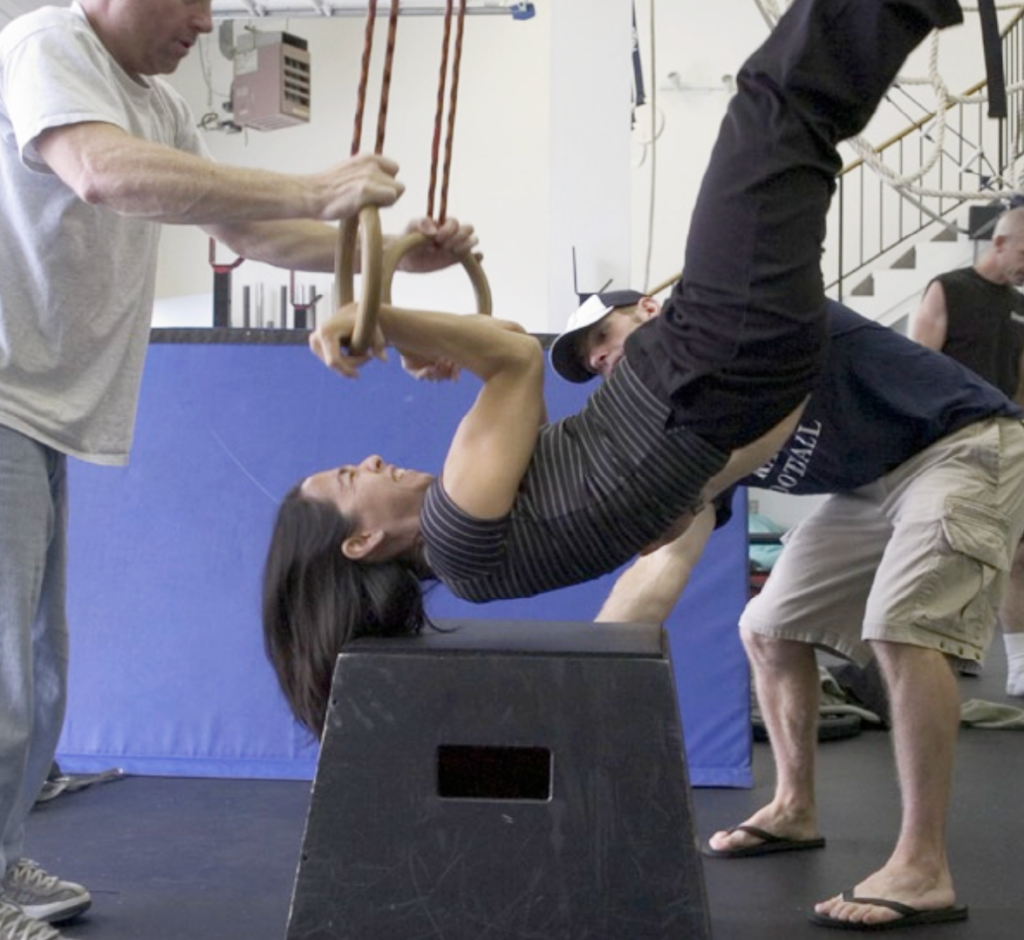
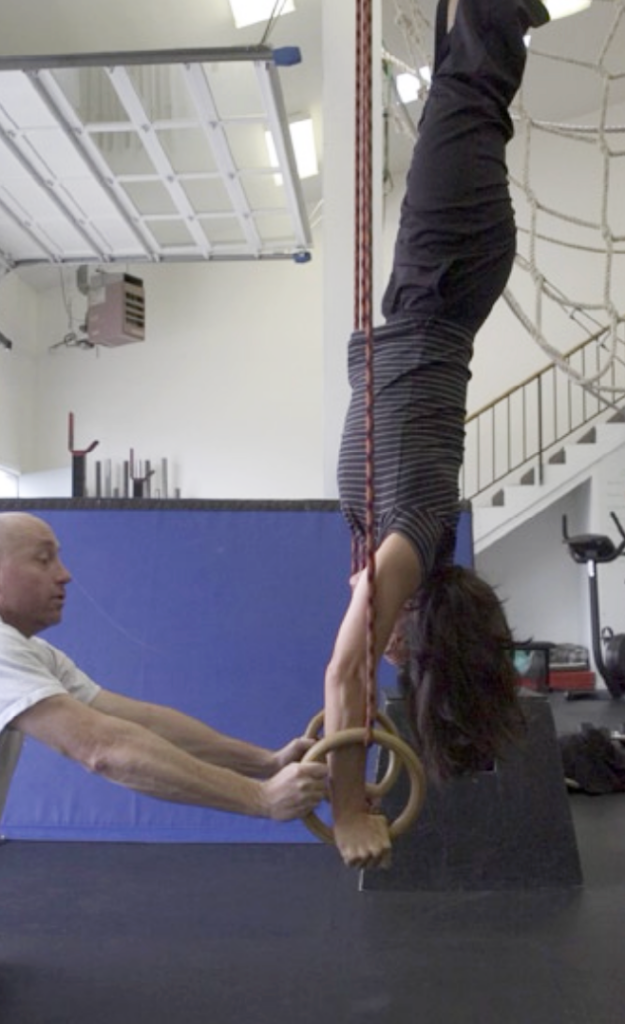
Matt Mast/Planche:
With rings, rope, pulley, and climbing harness Matt does a planche.
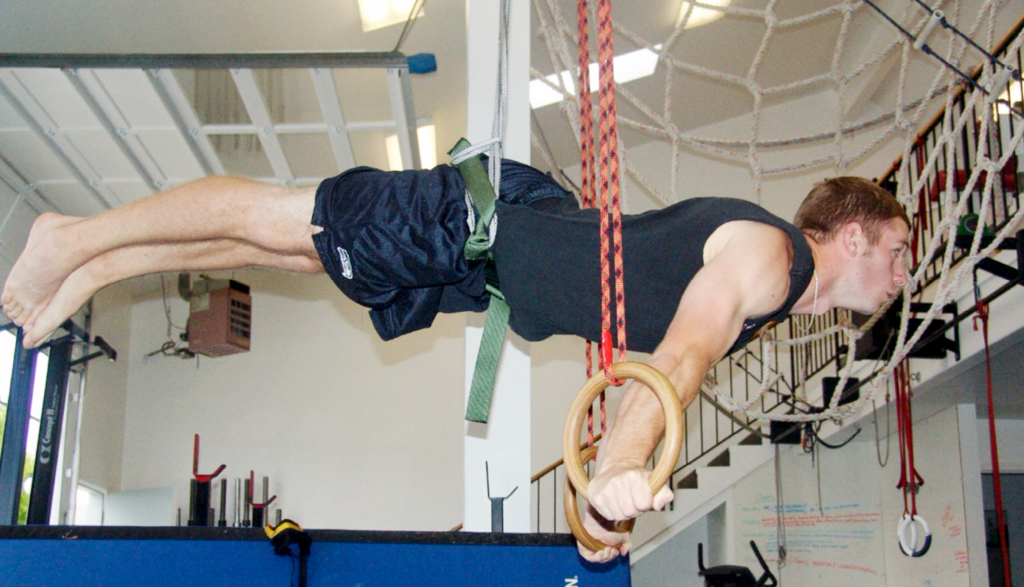
Matt Mast/Elevator:
The “elevator” starts with an inverted hang and false grip. The movement is performed by curling to the shoulder stand and then pressing to the handstand. This is like an upside down muscle-up and handstand push-up combination. It’s a whole lot easier at half body weight.
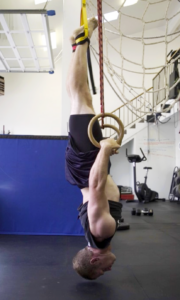
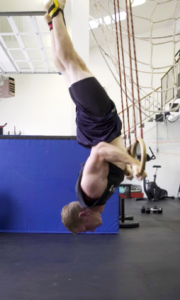
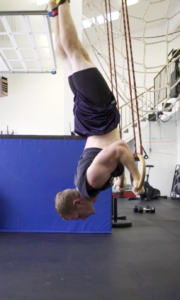
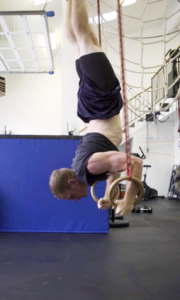
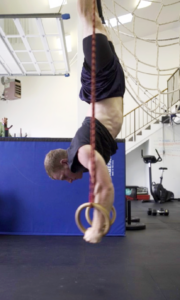
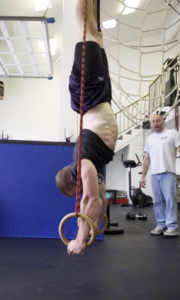
Garth Taylor/Front Lever:
Not too many guys at 270 pounds can do a front lever. With the ring and pulley set-up attached to a climbing harness his hips are lifted enough to make the move possible.
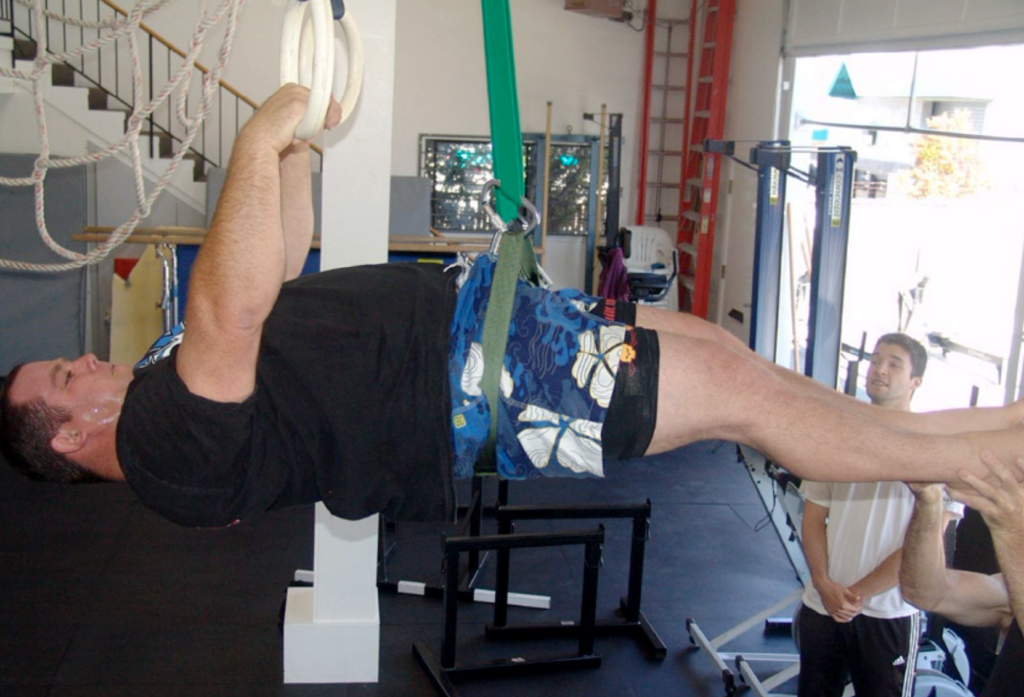
Sally Stade/Bar Dips:
Standing on a FlexBand looped over the ends of the parallel bars Sally Stade is able to perform dips. The assistance can be increased by adding another band or by twisting another loop around either or both bars.
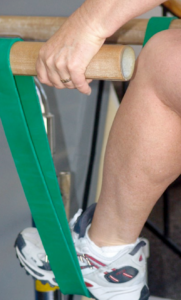
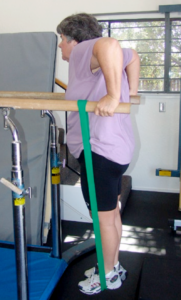

Sally Stade/Pull-ups:
Looping a FlexBand over the pull-up bar forms a loop into which Sally can stand and receive enough assistance to do pull-ups.
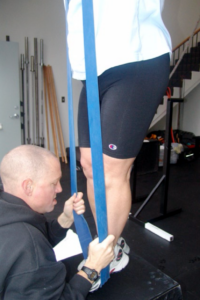
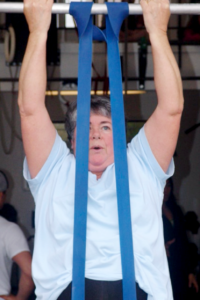
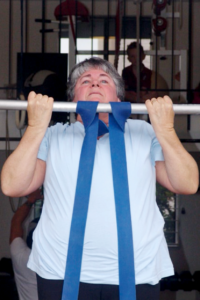
Sally Stade/Rope Climb:
Here Sally Stade, in a climbing harness, is attached to a FlexBand stretched and fixed to the same attachment point as the top of the rope. With the addition of another band Sally could climb the rope without using her legs.
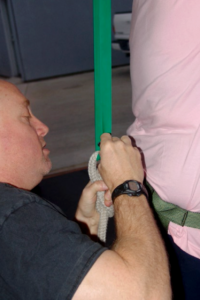
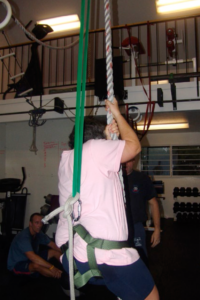
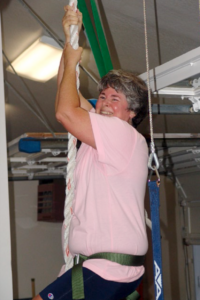
Equipment
Our old ankle harness looked like a leg restraint on an electric chair. It was designed with the same comfort in mind. This Yates harness is fantastic. Though featured as a wrist harness, it was tested and approved for ankle use. Not one athlete complained about discomfort. We can’t imagine a better, safer, more comfortable way to haul someone upside down.
This inexpensive pulley squeaked intolerably until we hit it with some WD-40. It seems to have moderate rolling resistance.
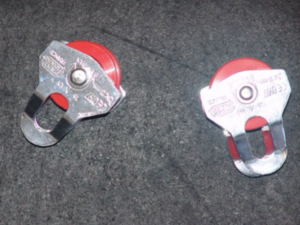
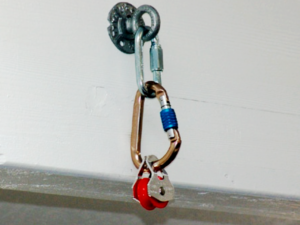
Our harness was manufactured by our military friends. Our next one will come from Metolius.
Band set. Get at least a light, average, and strong band. More if you can afford it.
- Download Original PDF
- Download Español (Spanish) PDF
- Download Português (Portuguese) PDF
- Download Italiano (Italian) PDF
- Download Français (French) PDF
Greg Glassman founded CrossFit, a fitness revolution. Under Glassman’s leadership there were around 4 million CrossFitters, 300,000 CrossFit coaches and 15,000 physical locations, known as affiliates, where his prescribed methodology: constantly varied functional movements executed at high intensity, were practiced daily. CrossFit became known as the solution to the world’s greatest problem, chronic illness.
In 2002, he became the first person in exercise physiology to apply a scientific definition to the word fitness. As the son of an aerospace engineer, Glassman learned the principles of science at a young age. Through observations, experimentation, testing, and retesting, Glassman created a program that brought unprecedented results to his clients. He shared his methodology with the world through The CrossFit Journal and in-person seminars. Harvard Business School proclaimed that CrossFit was the world’s fastest growing business.
The business, which challenged conventional business models and financially upset the health and wellness industry, brought plenty of negative attention to Glassman and CrossFit. The company’s low carbohydrate nutrition prescription threatened the sugar industry and led to a series of lawsuits after a peer-reviewed journal falsified data claiming Glassman’s methodology caused injuries. A federal judge called it the biggest case of scientific misconduct and fraud she’d seen in all her years on the bench. After this experience Glassman developed a deep interest in the corruption of modern science for private interests. He launched CrossFit Health which mobilized 20,000 doctors who knew from their experiences with CrossFit that Glassman’s methodology prevented and cured chronic diseases. Glassman networked the doctors, exposed them to researchers in a variety of fields and encouraged them to work together and further support efforts to expose the problems in medicine and work together on preventative measures.
In 2020, Greg sold CrossFit and focused his attention on the broader issues in modern science. He’d learned from his experience in fitness that areas of study without definitions, without ways of measuring and replicating results are ripe for corruption and manipulation.
The Broken Science Initiative, aims to expose and equip anyone interested with the tools to protect themself from the ills of modern medicine and broken science at-large.
Support the Broken Science Initiative.
Subscribe today →
recent posts
The Daley Fix | Introducing MetFix Spark
A low-carb holiday table that still feels like Thanksgiving.
